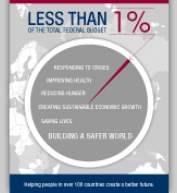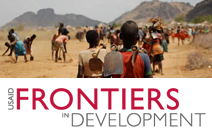- Agriculture and Food Security
- Democracy, Human Rights and Governance
- Economic Growth and Trade
- Education
- Environment and Global Climate Change
- Frontiers in Development
- Gender Equality and Women's Empowerment
- Global Health
- Science, Technology and Innovation
- Water and Sanitation
- Working in Crises and Conflict
- Responding in Times of Crisis
- Crises and Conflict Countries
- How We Do It
- Where We Work
- Afghanistan
- Benin
- Bosnia and Herzegovina
- Bulgaria
- Burkina Faso
- Burma
- Cambodia
- Cameroon
- Central African Republic
- Chad
- China
- Comoros
- Côte d’Ivoire
- Democratic Republic of the Congo
- Ecuador
- El Salvador
- Ethiopia
- Fiji
- Ghana
- Guatemala
- Haiti
- Honduras
- Horn of Africa
- India
- Indonesia
- Kenya
- Lesotho
- Liberia
- Madagascar
- Malawi
- Mali
- Mauritania
- Montenegro
- Mozambique
- Niger
- Pakistan
- Papua New Guinea
- Paraguay
- Philippines
- Republic of the Congo
- Senegal
- Somalia
- South Sudan
- Sri Lanka
- Sudan
- Syria
- Tanzania
- Thailand
- The Gambia
- The Sahel
- Tunisia
- Turkey
- Tuvalu
- Vietnam
- Yemen
- Why It Matters
- How To Help
- Resources
- Building Resilience
- Conflict Mitigation and Prevention
- Disaster Risk Reduction
- Peacebuilding and Reconciliation
- Promoting Peaceful Political Transitions
- Providing Safe & Secure Environments for Development
- Recovering From Crisis
- World Humanitarian Day
- Responding in Times of Crisis
Philippines

To date in FY 2012, USAID has responded to two flooding disasters in the Philippines—heavy rains from Tropical Storm Washi that produced flash floods in the Mindanao island group in the southern Philippines in December 2011, as well as heavy monsoon rains exacerbated by Typhoon Haikui that caused flooding in the metropolitan Manila area and northern and eastern regions of the Philippines in August 2012.
USG HUMANITARIAN FUNDING PROVIDED IN FY 2012
|
USAID/OFDA Assistance to the Philippines |
$6,868,602* |
|
USAID/Philippines Assistance to the Philippines |
$769,000 |
|
Total USAID and State Assistance to the Philippines |
$7,637,602 |
*This figure includes funding for both disaster response and disaster risk reduction activities. (As of August 13, 2012)
Latest Philippines Fact Sheet
USAID/DCHA FY 2012 Philippines Floods Fact Sheet #1 (218kb PDF) and map (377kb PDF)
Key Developments
On December 16, 2011, heavy rains from Tropical Storm Washi, known locally as Sendong, combined with high tides and strong currents to produce flash floods in the Mindanao island group in the southern Philippines, particularly in the most affected Iligan and Cagayan de Oro cities. Flash floods occurred at night while most people were asleep, increasing the death toll, according to local media reports. As of January 13, 2012, floods and accompanying landslides had killed nearly 1,300 people and displaced approximately 69,300 others, according to the Government of the Republic of the Philippines National Disaster Risk Reduction and Management Council (NDRRMC). In addition, NDRRMC reported that winds, floods, and landslides damaged or destroyed nearly 52,000 houses.
On December 19, 2011, U.S. Ambassador Harry K. Thomas Jr. declared a disaster due to the effects of the storm. In response, USAID’s Office of U.S. Foreign Disaster Assistance (USAID/OFDA) provided more than $2 million for emergency shelter; water, sanitation, and hygiene (WASH) activities; and temporary employment opportunities for people whose livelihoods were disrupted by the tropical storm. USAID/OFDA also supported distribution of emergency relief supplies to vulnerable, affected individuals.
In early August 2012, heavy monsoon rains exacerbated by Typhoon Haikui caused flooding in the metropolitan Manila area and much of northern and eastern Philippines, killing 95 people, displacing approximately 580,000 others, and affecting 3 million individuals. Prior floods over the previous two weeks had resulted in 53 deaths nationwide.
In response to an August 7, 2012, disaster declaration, USAID/OFDA provided $500,000 for the distribution of emergency relief supplies to flood-affected populations, as well as logistics and WASH support. In addition, USAID/OFDA staff traveled to the Philippines to conduct a joint assessment of flood-affected areas with the Australian Government Overseas Aid Program to evaluate humanitarian needs.
@theOFDA
-
theOFDA
MT @USAID: We are the largest provider of in-kind food aid + one of largest providers of cash-based food asst in the world. #WFD2012
6 hours 4 min ago.
-
theOFDA
RT @UNICEF: Did you know handwashing with soap is the single most cost-effective health intervention ever? #iwashmyhands Please RT!
4 days 13 hours ago.
-
theOFDA
Women and Girls Reduce Disaster Risk Every Day t.co/ZGNjnYIf #IDDR
4 days 17 hours ago.








Comment
Make a general inquiry or suggest an improvement.